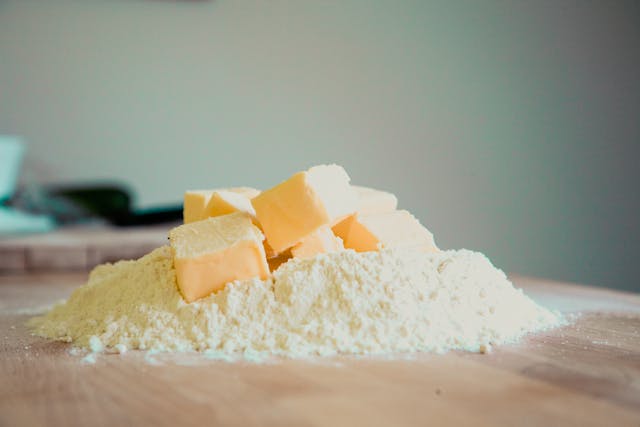
What is self-raising flour? Self-raising (self-rising in the US) flour is wheat flour that has the leavening agent (usually baking powder) and sometimes salt already added to it.
The purpose of self-raising flour is to (as it says in the name) rise on its own, which means without adding any other ingredients. When you are making bread, especially, but also other baked goods, you usually want them to rise so that they are fluffy. The yeast in the bread has always been the main rising agent that it used. Yeast is a single-cell fungus that is alive when you put it into the bread mix. The fungus is woken up by the water that you add to the mix, and it starts to feed. The yeast eats the sugar that is naturally in the flour and the extra sugar that you added (if you added any), which it turns into energy. As a byproduct of this process, it produces alcohol and carbon dioxide. The bubbles of carbon dioxide get trapped in the dough and they make it rise. When you bake the bread, you kill the yeast, burn off the alcohol, and trap the bubbles of carbon dioxide in the bread. It is these pockets of carbon dioxide that give bread its fluffiness. Yeast has been used to make bread for thousands of years. The earliest bread ever found was 14,000 years old. However, yeast is not fas,t and it can take a long time for the bread to rise to the desired size. This is where leavening agents, usually baking powder, come in.
Leavening agents are chemicals that are used to leaven (raise) bread. Baking powder is a mix of sodium bicarbonate and an acid salt. As long as the powder is kept dry, the sodium bicarbonate and the acid salt are inert, and nothing happens. As soon as they come into contact with water, the two chemicals start to react. The reaction is fairly fast, and it produces a lot of carbon dioxide. If you have added baking powder to your bread mix, then it will start to react as soon as you add the water, and the bread will begin to rise. The process is faster than yeast and makes the bread baking process faster.
So, what is the need for self-raising flour? The baking powder in the self-raising flour is thoroughly mixed in, and the balance is all but perfect. If you added the baking powder yourself, you could mix it in well, but it would take you a while. You may also end up with clumps of baking powder, which would mean that your bread would not rise evenly. Self-raising flour makes baking easier, and it makes everything more consistent.
Self-raising flour was invented by a British baker called Henry Jones in 1845. He tried mixing several different leavening agents together until he hit on the perfect concoction, which was sodium bicarbonate, tartaric acid, and plain flour. He applied for and received a patent for the product in 1845, and it was an instant hit. Months after receiving the patent, he was made the Royal Purveyor of self-raising flour and biscuits to Queen Victoria. Demand skyrocketed, and he became a wealthy man. Henry Jones had a couple of reasons for coming up with his self-raising flour. The first was obviously ease. Having everything in one bag made baking much easier for all and sundry. However, his main reason was probably that there was no dried yeast available. Nobody knew that yeast was the fungus responsible for making bread rise. Yeast wouldn’t be discovered by Louis Pasteur until 1857. People knew that the byproduct of beer, which was yeast, would make bread rise, but yeast as an individual substance was not known. Today, we can buy a pack of dried yeast and keep it for months before we use it. That was not possible when Henry Jones was baking. His self-raising flour would allow people to make bread without yeast. This was very important if you were a sailor. Sailors for the British Navy would spend months away at sea. The ships couldn’t carry fresh bread, and they couldn’t carry anything with yeast in it because it would go rotten and die. Sailors had to live on hardtack, which was a very hard cracker made from flour, water, and salt. Henry Jones’s self-raising flour made it possible to bake bread on ships. It seems like an obvious thing, but it took Henry Jones 10 years to convince the navy that they should use his self-raising flour on their ships. In fact, if it hadn’t been for Florence Nightingale in the Crimean War, the navy might never have changed its mind. And this is what I learned today.
Sources
https://www.foodnetwork.com/how-to/packages/help-around-the-kitchen/how-to-make-self-rising-flour
https://en.wikipedia.org/wiki/Flour
https://en.wikipedia.org/wiki/Henry_Jones_(baker)
https://en.wikipedia.org/wiki/Leavening_agent
https://www.thoughtco.com/how-baking-powder-works-607382
https://en.wikipedia.org/wiki/Baking_powder
https://www.exploratorium.edu/explore/cooking/bread-science
https://www.bristolpost.co.uk/news/history/bristol-baker-who-invented-self-6421112
Photo by Markus Spiske: https://www.pexels.com/photo/bakery-flour-cooking-baking-94443/
